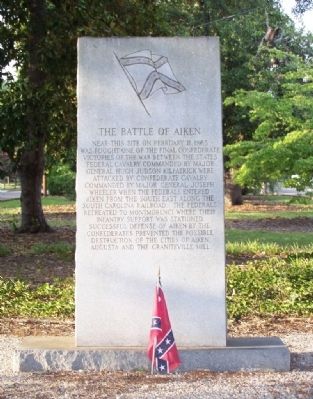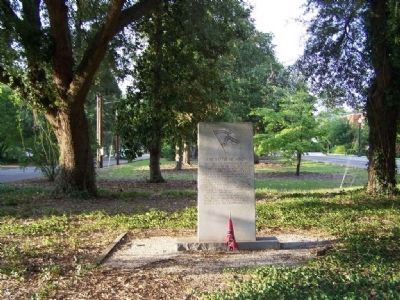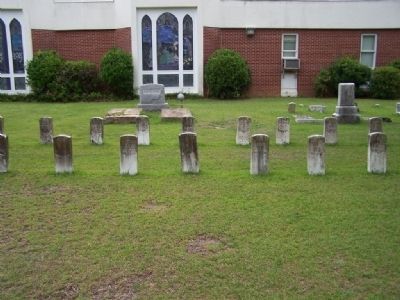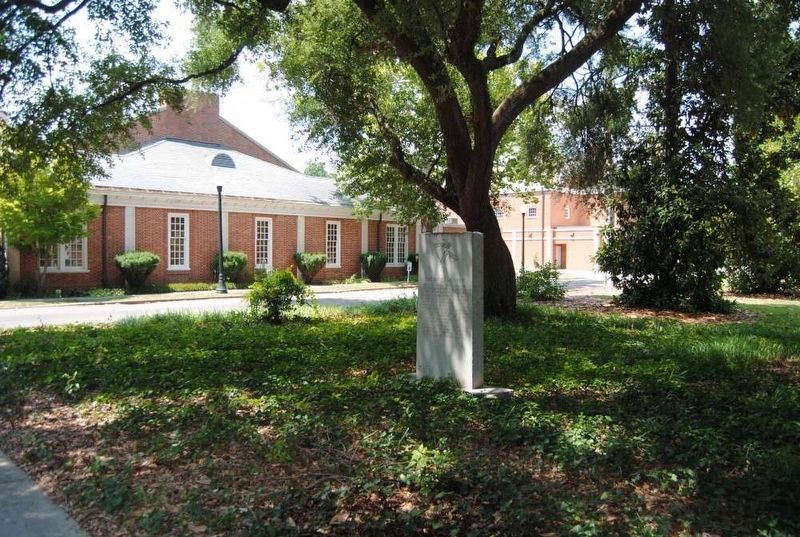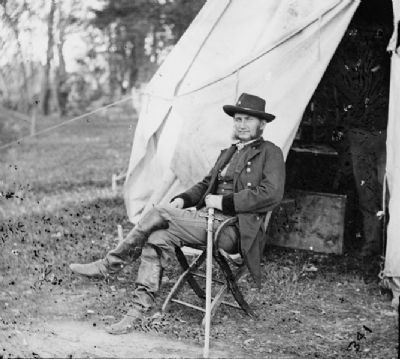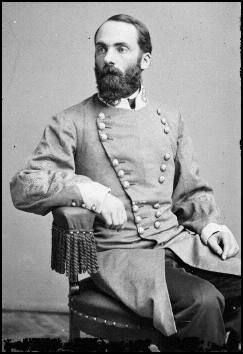Aiken in Aiken County, South Carolina — The American South (South Atlantic)
Battle of Aiken
Near this spot on February 11, 1865 was fought one of the final Confederate victories of the War Between The States. Federal Cavalry commanded by Major General Hugh Judson Kirkpatrick were attacked by Confederate Cavalry commanded by Major General Joseph Wheeler when the Federals entered Aiken from the south east along the South Carolina Railroad. The Federals retreated to Montmorenci where their infantry support was stationed. Successful defense of Aiken by the Confederates prevented the possible destruction of the cities of Aiken, Augusta and the Graniteville Mill.
Erected 1960 by Aiken County Historical Commission.
Topics. This historical marker is listed in this topic list: War, US Civil. A significant historical month for this entry is February 1805.
Location. 33° 33.643′ N, 81° 43.153′ W. Marker is in Aiken, South Carolina, in Aiken County. Marker is on Chesterfield Street NE near Richland Avenue (U.S. 78), in the median. Touch for map. Marker is in this post office area: Aiken SC 29801, United States of America. Touch for directions.
Other nearby markers. At least 10 other markers are within walking distance of this marker. The Detection of the Neutrino, 1956 / The Nobel Prize In Physics, 1995 (within shouting distance of this marker); St. John's Methodist Church (about 400 feet away, measured in a direct line); Defense of Aiken (about 400 feet away); Aiken County Confederate Monument (about 500 feet away); Original Survey of Aiken (about 500 feet away); Aiken First Baptist Church (about 500 feet away); Aiken County 125th Anniversary (about 500 feet away); William Aiken, Sr. (about 700 feet away); H. Odell Weeks (about 800 feet away); James F. Byrnes (approx. 0.2 miles away). Touch for a list and map of all markers in Aiken.
Also see . . .
1. Joseph Wheeler. In late 1864 Wheeler's cavalry was virtually the only effective Confederates to oppose Sherman's March to the Sea throughout the rest of the year. (Submitted on August 8, 2008, by Mike Stroud of Bluffton, South Carolina.)
2. Hugh Judson Kilpatrick. Hugh Judson Kilpatrick (January 14, 1836 – December 4, 1881) was an officer in the Union Army during the American Civil War, achieving the rank of brevet major general. (Submitted on March 14, 2009, by Brian Scott of Anderson, South Carolina.)
3. The Battle of Aiken, SC - 2008. The Battle of Aiken, SC behind the lines of the 22NC Co. B. (Submitted on January 5, 2011, by Brian Scott of Anderson, South Carolina.)
4. The Battle of Aiken - 2009. Battle of Aiken Reenactment, 2009, Aiken, South Carolina (Submitted on January 5, 2011, by Brian Scott of Anderson, South Carolina.)
5. The Battle of Aiken - 2010. On Feb. 20, 2010, 400 re-enactors took part in the 145th anniversary of the Battle of Aiken (S.C.) during the Civil War. (Submitted on January 5, 2011, by Brian Scott of Anderson, South Carolina.)
Additional commentary.
1. Battle of Aiken Reenactment
Every February, Confederate and Union reenactors come to Aiken to re-stage the battle
— Submitted August 31, 2008, by Brian Scott of Anderson, South Carolina.
2. Battle of Aiken Monument
The dedication ceremony for this six-foot granite marker was held on Saturday, February 13, 1960. Rain drove the crowd of 200 inside nearby St. John's Methodist Church. John H. Staubes, Sr., chairman of the Aiken County Historical Commission, was master of ceremonies. Mayor Odell weeks welcomed the visitors to the city. Rep. Robby Bell of Lancaster responded for the visitors. Rep. John May of Aiken introduced the speaker, William D. Workman, Jr., historian and author of The Case for the South...This was believed
to be the first Centennial celebration of the Confederacy in the South. (Source: A Guide to Confederate Monuments in South Carolina: "Passing the Silent Cup" by Robert S. Seigler, 1997, pg. 48.)
— Submitted February 28, 2009, by Brian Scott of Anderson, South Carolina.
3. The Battle of Aiken
Aiken was the scene of a street battle on February 11, 1865. Union Major General Judson Kilpatrick's cavalry was surprised on both flanks by Confederate Major General Joe Wheeler's cavalry. Kilpatrick had been warned repeatedly that Wheeler's men were in the area possibly trying to set up a trip, but the man known as "Kit-Calvary" for his hard driving of men and horses could not have cared less. Dozens of Kilpatrick's men were cut down by Confederate pistols. Those who could still breathe turned tail and galloped off, with the Confederates in hot pursuit.
Kilpatrick led the scramble out of town, with several Confederates riding amongst the Federals in an attempt to pull the general off his horse and take him prisoner. If there was one thing Kilpatrick always did well, it was ride his horse away from Confederates. He escaped. More than ninety Federals were taken prisoner. Kilpatrick's hat was also captured. (Source: Touring the Carolina's Civil War Sites by Clint Johnson, pg 365.)
— Submitted March 14, 2009, by Brian Scott of Anderson, South Carolina.
4. Joseph Wheeler (1836 - 1906)
Joseph, a Representative from Alabama; born in Augusta, Ga., September 10, 1836; attended local schools and the Episcopal Academy, Cheshire, Conn.; was graduated from the United States Military Academy at West Point, 1859; attended the Cavalry School at Carlisle, Pa., 1859-1860; transferred to the Mounted Rifles June 26, 1860; second lieutenant September 1, 1860, and served in New Mexico; resigned from the United States Army February 27, 1861; appointed lieutenant of Artillery in the Confederate Army on April 3, 1861; successively promoted to the grade of colonel, brigadier general, and major general, and was commissioned lieutenant general in February 1865; in 1862 was assigned to the command of the Army Corps of Cavalry of the Western Army, continuing in that position until the war closed; senior Cavalry general of the Confederate Armies May 11, 1864; studied law; was admitted to the bar and engaged in practice at Wheeler, Ala., and also became a planter; presented credentials as a Democratic Member-elect to the Forty-seventh Congress and served from March 4, 1881, to June 3, 1882, when he was succeeded by William M. Lowe, who contested his election; subsequently
elected to the same Congress to fill the vacancy caused by the death of William M. Lowe and served from January 15 to March 3, 1883; elected as a Democrat to the Forty-ninth and to the seven succeeding Congresses and served from March 4, 1885, to April 20, 1900, when he resigned; chairman, Committee on Expenditures in the Department of the Treasury (Fiftieth Congress), Committee on Territories (Fifty-third Congress); served in the Spanish-American War; commissioned major general of Volunteers May 4, 1898, and assigned to command of a Cavalry division, United States Army; senior member of the commission which negotiated the surrender of Santiago and the Spanish Army in Cuba; during the Philippine Insurrection commanded the First Brigade, Second Division, Eighth Army Corps, in the Tarlac campaign and in several other operations in central Luzon from July 8, 1899, to January 24, 1900; commissioned brigadier general in the United States Regular Army June 16, 1900; retired September 10, 1900; died in Brooklyn, N.Y., January 25, 1906; interment in Arlington National Cemetery. (Source: Biographical Directory of the U.S. Congress.)
— Submitted January 5, 2011, by Brian Scott of Anderson, South Carolina.
Credits. This page was last revised on December 9, 2021. It was originally submitted on August 8, 2008, by Mike Stroud of Bluffton, South Carolina. This page has been viewed 8,057 times since then and 312 times this year. Photos: 1, 2, 3. submitted on August 8, 2008, by Mike Stroud of Bluffton, South Carolina. 4. submitted on March 26, 2017, by Brian Scott of Anderson, South Carolina. 5, 6. submitted on March 14, 2009, by Brian Scott of Anderson, South Carolina. • Craig Swain was the editor who published this page.
